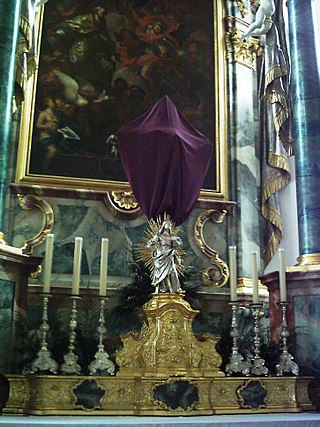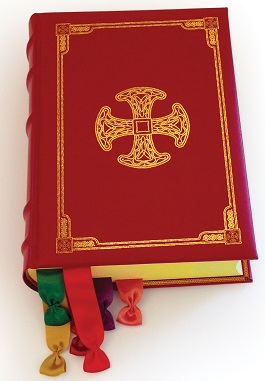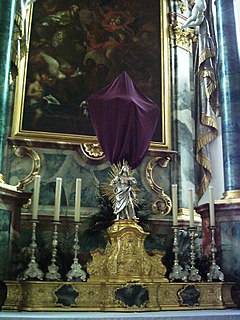
The Roman Missal is the title of several missals used in the celebration of the Roman Rite. Along with other liturgical books of the Roman Rite, the Roman Missal contains the texts and rubrics for the celebration of the most common liturgy and Mass of the Catholic Church.

The liturgical year, also called the church year, Christian year or kalendar, consists of the cycle of liturgical seasons in Christian churches that determines when feast days, including celebrations of saints, are to be observed, and which portions of Scripture are to be read either in an annual cycle or in a cycle of several years.

The Mass of Paul VI, also known as the Ordinary Form or Novus Ordo, is the most commonly used liturgy in the Catholic Church. It was promulgated by Pope Paul VI in 1969 and its liturgical books were published in 1970; those books were then revised in 1975, they were revised again by Pope John Paul II in 2000, and a third revision was published in 2002.

The Tridentine Mass, also known as the Traditional Latin Mass or the Traditional Rite, is the liturgy in the Roman Missal of the Catholic Church codified in 1570 and published thereafter with amendments up to 1962. Celebrated almost exclusively in Ecclesiastical Latin, it was the most widely used Eucharistic liturgy in the world from its issuance in 1570 until the introduction of the Mass of Paul VI.

Holy Week is the most sacred week in the liturgical year in Christianity. For all Christian traditions, it is a moveable observance. In Eastern Christianity, which also calls it Great Week, it is the week following Great Lent and Lazarus Saturday, starting on the evening of Palm Sunday and concluding on the evening of Great Saturday. In Western Christianity, Holy Week is the sixth and last week of Lent, beginning with Palm Sunday and concluding on Holy Saturday.
In the Latin liturgical rites of the Catholic Church, a commemoration is the recital, within the Liturgy of the Hours or the Mass of one celebration, of part of another celebration that is generally of lower rank and impeded because of a coincidence of date.

Passiontide is a name for the last two weeks of Lent, beginning on the Fifth Sunday of Lent, long celebrated as Passion Sunday, and continuing through Lazarus Saturday. It commemorates the suffering of Christ. The second week of Passiontide is Holy Week, ending on Holy Saturday.
The General Instruction of the Roman Missal (GIRM)—in the Latin original, Institutio Generalis Missalis Romani (IGMR)—is the detailed document governing the celebration of Mass of the Roman Rite in what since 1969 is its normal form. Originally published in 1969 as a separate document, it is printed at the start of editions of the Roman Missal since 1970.

In the Roman Rite of the Catholic Church, Lutheranism, Methodism and Anglicanism, an altar bell is typically a small hand-held bell or set of bells. The primary reason for the use of such bells is to create a “joyful noise to the Lord” as a way to give thanks for the miracle taking place atop the altar.
The text and rubrics of the Roman Canon have undergone revisions over the centuries, while the canon itself has retained its essential form as arranged no later than the 7th century. The rubrics, as is customary in similar liturgical books, indicate the manner in which to carry out the celebration.

The Mass of the Lord's Supper, also known as A Service of Worship for Maundy Thursday, is a Holy Week service celebrated on the evening of Maundy Thursday. It inaugurates the Easter Triduum, and commemorates the Last Supper of Jesus with his disciples, more explicitly than other celebrations of the Mass.
Orate fratres is the incipit of a request for prayer that the priest celebrating Mass of the Roman Rite addresses to the faithful participating in it before saying the Prayer over the Offerings, formerly called the Secret. It thus corresponds to the Oremus said before the Collect and the Postcommunion, and is an expansion of those shorter exhortations. It has gone through several alterations since the Middle Ages.
The ranking of liturgical days in the Roman Rite is a regulation for the liturgy of the Roman Catholic church. It determines for each liturgical day which observance has priority when liturgical dates and times coincide, which texts are used for the celebration of the Holy Mass and the Liturgy of the hours and which liturgical color is assigned to the day or celebration.
The Code of Rubrics is a three-part liturgical document promulgated in 1960 under Pope John XXIII, which in the form of a legal code indicated the liturgical and sacramental law governing the celebration of the Roman Rite Mass and Divine Office.
Order of Mass is an outline of a Mass celebration, describing how and in what order liturgical texts and rituals are employed to constitute a Mass.

The Friday of Sorrows is a solemn pious remembrance of the sorrowful Blessed Virgin Mary on the Friday before Palm Sunday held in the fifth week of Lent. In the Anglican Ordinariate's Divine Worship: The Missal it is called Saint Mary in Passiontide and sometimes it is traditionally known as Our Lady in Passiontide.

Divine Worship: The Missal (DW:TM) is the liturgical book containing the instructions and texts for the celebration of Mass by the former Anglicans within the Catholic Church in the three personal ordinariates of Great Britain, United States and Canada, and Australia. The rite contained in this missal is the Anglican Use, a liturgical use of the Roman Rite Mass with elements of Anglican worship. It was approved for use beginning on the first Sunday of Advent, November 29, 2015.

A communion-plate is a metal plate held under the chin of a communicant while receiving Holy Communion in the Catholic Church. Its use was common in the last part of the nineteenth century and during most of the twentieth.
The Ordo Lectionum Missae, commonly referred to as OLM, is the main liturgical lectionary used in the Roman Catholic Church. It contains the designated Scripture readings for the celebration of the Mass of Paul VI, encompassing selections (pericopes) from both the Old and New Testaments of the Bible.

Lenten shrouds are veils used to cover crucifixes, icons and some statues during Passiontide. Covering crucifixes and crosses, and in some places also statues, with the exception of those showing the suffering Christ, such as the Man of Sorrows, with purple or black cloths begins on the Saturday before the Passion Sunday. The cross is unveiled during its veneration on Good Friday while all the other Lenten shrouds are taken off during the Easter Vigil. The use of Lenten shrouds occurs in churches of the Catholic, Lutheran, and Anglican denominations.













